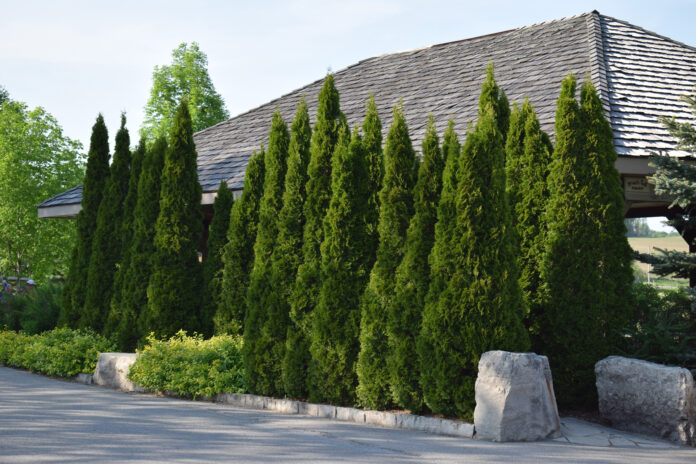
The pandemic has encouraged us to embrace change. You may let your hair grow a little longer between cuts, make fewer trips to the grocery store and chances are that you know your neighbours a little better.
Speaking of neighbours, this may be a good time to consider creating a healthy green or flowering hedge between your properties. You may want the added privacy, support your local pollinating insects, a nesting place for birds or the sound barrier that, as it matures, is much more effective than a wooden fence.
Here are our top 6 favourite hedging plants:
Cedars. Cedars are almost permanent (they last several times longer than a wooden fence), evergreen and suit the narrow, linear space we usually allocate to a hedge. All cedars require a minimum of 6 hours sunshine a day. There are two popular hedging species of cedar used in Canada: native white cedars and Emerald (‘Smaragd’) cedars.
White cedars. Often harvested from the wild, look for nursery-grown to be sure that they have not been poached from an unsuspecting landowner. Nursery-grown trees also transplant better as they are grown in pots. Start small for best results, around a metre high, as youngsters will put down roots quickly and outgrow their more mature counter parts. They cost less and require less TLC to get them started. White cedars lend themselves to formal pruning.
Emerald Cedars. A cultivar developed in Denmark a couple of generations ago. They feature an emerald green appearance and never need pruning, provided they have adequate space. Start with locally grown stock as they are better suited to our climate. Start these specimens small also.
Bridal Wreath Spirea. Come late May and early June, brilliant white hedges burst into bloom everywhere. This winter hardy flowering shrub has proven itself for several generations as a disease resistant, fast growing flowering hedge that is economical (especially compared to a wooden fence) and easy to manage in the range of two to three metres high. Prune now, mid-summer, for best results.
Lilac. Do not plant common lilac, which is a weed of a shrub, unless you have plenty of real estate for it to spread. Better to stick to the easier to control dwarf Korean lilac (ultimate height two metres), French Hybrid (mature to about three to four metres and very fragrant) or Chinese lilac (three to four metres, later flowering). All lilacs, except for the Korean cultivar, will grow at least two metres wide. Prune now.
Hill’s Yew. An elegant, richly textured evergreen hedge about a metre to a metre and a half high and wide. Prune after first flush of growth in June or July. A fabulous permanent hedge that is tolerant of moderate shade (requires a minimum of 3 hours sun to look its best) and improves in appearance for decades. We know of some Hill’s yew hedges that Ben’s grandfather planted in the ‘60s in Toronto that still look great.
Boxwood. A broad-leafed evergreen that creates a permanent metre-high hedge. Boxwood lends itself to pruning in most any shape. Rounded, squared or you can prune them into animal shapes. Slow to start but worth the wait.
Hedge planting. Dig a trench about twice as wide and several centimetres deeper than the root mass of the hedging plants. Line the bottom of the trench with quality triple mix, enough to raise the hedge above grade by 5 or 6 centimetres. As you line the plants up, firm soil around every side of the roots with the heal of your boot and water generously. Continue to keep wet for the first couple of weeks, gradually allowing the soil to dry about four or five centimetres below the surface. Annual pruning keeps them in good shape.
Of all the choices that you make regarding home improvement, we recommend hedging your bets – especially against the cost of lumber.
Mark Cullen is an expert gardener, author, broadcaster, tree advocate and Member of the Order of Canada. His son Ben is a fourth-generation urban gardener and graduate of University of Guelph and Dalhousie University in Halifax. Follow them at markcullen.com, @markcullengardening, and on Facebook.

